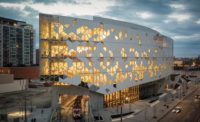The Centre for Environmental Planning and Technology (CEPT), in Ahmedabad holds a special place in the hearts and minds of the generations of architects who have studied there since the school’s beginnings in the early 1960s. Designed by famed Indian architect Balkrishna Doshi, now age 90, who served as the CEPT’s first director, the collection of mostly 1970s buildings are highly indebted to Le Corbusier and Louis Kahn—who both left their mark on the western Indian city. The complex is exposed brick and concrete and has an expressed solidity and rigorous structural logic, according to Rahul Mehrotra, a CEPT alum and founder of RMA Architects. His Mumbai- and Boston-based firm was invited to build CEPT’s new Lilavati Lalbhai Library, which opened this past October.
Additional Content:
Jump to credits & specifications
Designing the first structure on campus not by Doshi was “intimidating, to say the least,” says Mehrotra, known primarily for his work in his native country, though he has also completed a house in Pakistan and a lab and office building in Basel for Novartis. Mehrotra confesses that the CEPT commission made him “a bit anxious about getting it as right as possible.” Accordingly, his library scheme pays homage to the Indian Modern master, as well as Ahmedabad’s rich midcentury heritage. But, at the same time, it reinvents the older architectural ideas. Mehrotra made the library no higher than CEPT’s existing buildings—all three stories tall—but in order to fit the required 30,000-square-foot program on the constrained site, he submerged half of the building. A central book core, surrounded by study carrels, with archives at the base, extends almost 40 feet down into the ground, a strategy that provides a geothermal advantage in the hot climate. The three stories above grade house exhibition spaces and reading rooms. To accommodate this arrangement, the RMA team created something that resembles a building within a building: an inner one with a steel structure and a skin of drywall and glass, and an outer one defined by manually operated shutters, atop a sculptural concrete base.
The shutters serve the same function as the brise soleil on Le Corbusier’s Mill Owners’ Association Building located just a few miles away. But the new library’s outer shell is of a completely different character than that of the 1950s structure, as well as a departure from the material palette of the surrounding campus buildings. Instead of static concrete elements, or the solidity of brick, Mehrotra’s library has delicate plywood slats that can be adjusted and shifted to mitigate the sun or let the breezes in. The result is a building much like a kaavad—a traveling shrine, in which layers of doors are opened, each revealing a different episode in a continuous narrative.
There are plans for the school to use this double skin as a learning tool, studying the details, monitoring its operations, and measuring light levels and temperatures in different seasons and throughout the course of the day. No special documentation process is needed, however, to demonstrate the effectiveness of the finned facades, along with skylights on the roof, which bring daylight deep into the library, reaching almost to its lowest level. The sun, of course, readily illuminates the more transparent abovegrade floors, where the building seems to fly into the trees and students can study amid the leaves and the birds.
Some spaces are literally open to the campus, such as an upper-level terrace that occupies the interstitial zone between the outer and inner shells. It offers a sheltered spot for relaxed meetings and socializing. The informality flows out of the building too, with people using its exterior areas in a similarly low-key way—lounging on the deep, shaded sills of the base, chatting with each other, and eating lunch. It is clear that the students have taken to the library, making it their own. And in this way, the youthful building establishes a new centrifugal core for its storied campus.
With reporting by Kaiwan Mehta. Mehta is a Mumbai-based architecture theorist, educator, researcher, and managing editor of DOMUS India.
CreditsArchitect: RMA Architects — Rahul Mehrotra, founder and principal; Robert
Campus Architect: Aakruti Architects — Dilip Patel, principal
Engineers N.K. Shah Architects & Structural Consultants (structural); ARKK Consulting (m/e/p)
General contractor: PSP Projects
Client: CEPT University |
SpecificationsClosers Dorma
Glazing Saint-Gobain
Suspension Grid Hunter Douglas
Paints and Stains Oikos
Elevators Infinity Elevators |
















